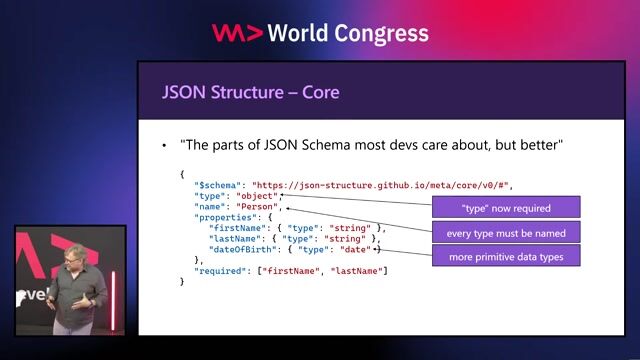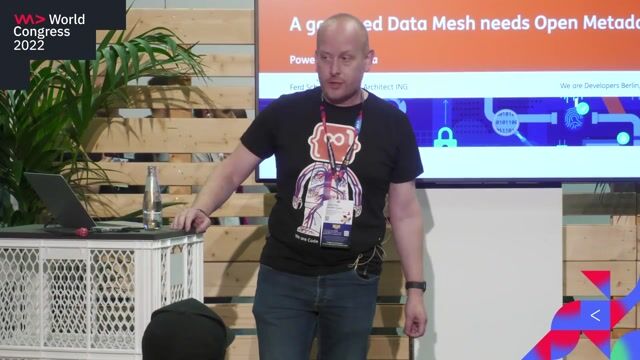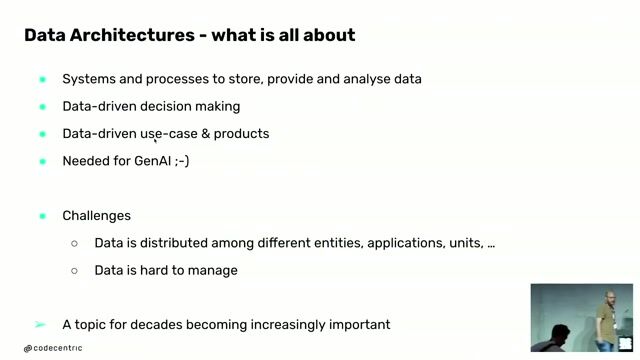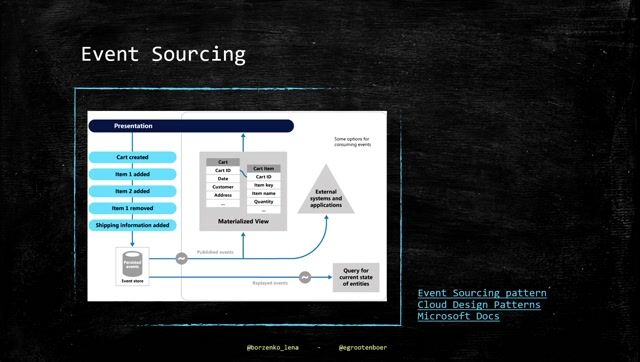Clemens Vasters
Bringing Clarity to Event Streams: Enabling Analytics and AI Through Rich Metadata
#1about 3 minutes
The problem of ambiguous data without clear context
Examples with LLMs demonstrate how data without metadata, like temperature units, leads to inconsistent and unreliable interpretations.
#2about 5 minutes
Using schemas to provide necessary data constraints
Providing a schema with explicit constraints and descriptions, such as units, enables LLMs to interpret data correctly and generate consistent results.
#3about 1 minute
Adopting a schema-first design for data structures
Data schemas should be created first and be independent of code assets, allowing code generation for polyglot applications and improving LLM performance.
#4about 3 minutes
Standardizing event structure using CNCF CloudEvents
Using a standard like CloudEvents provides a consistent envelope for events, preventing the chaotic and varied structures that LLMs might otherwise generate.
#5about 5 minutes
Automating client code generation with detailed metadata
By providing a comprehensive metadata document that includes endpoint and protocol details, LLMs can automatically generate complete and correct client code for publishers.
#6about 2 minutes
Moving beyond tribal knowledge in event pipelines
Current event pipelines often rely on informal communication, but a metadata-driven approach creates a formal contract that improves maintainability and compatibility.
#7about 6 minutes
A practical metadata-driven pipeline with Microsoft Fabric
A real-world example processing USGS water data demonstrates how a complete metadata definition using X Registry enables automated tooling and contract enforcement.
#8about 2 minutes
Introducing JSON Structure as a better schema language
JSON Structure is proposed as a stricter alternative to JSON Schema, designed as a data definition language with a better type system and namespace support.
#9about 4 minutes
Key standards for modern event-driven architecture
A summary of three key open standards—CloudEvents, X Registry, and JSON Structure—that provide the tools for building robust, metadata-driven systems.
Related jobs
Jobs that call for the skills explored in this talk.
Featured Partners
Related Videos
 20:29
20:29Introducing JSON Structure - A Better Schema
Clemens Vasters
 21:17
21:17Data is Key: Scraping Metadata from Websites
Lars Kölker
 38:36
38:36A Data Mesh needs Open Metadata
Ferd Scheepers
 45:36
45:36What is a Message Queue and when and why would I use it?
Clemens Vasters
 19:44
19:44Blueprints for Success: Steering a Global Data & AI Architecture
Dominik Schneider
 29:25
29:25Modern Data Architectures need Software Engineering
Matthias Niehoff
 30:51
30:51Why and when should we consider Stream Processing frameworks in our solutions
Soroosh Khodami
 32:03
32:03Implementing an Event Sourcing strategy on Azure
Eldert Grootenboer & Olena Borzenko-Turianska
From learning to earning
Jobs that call for the skills explored in this talk.
Data Enterprise Architect (AWS + Snowflake)
Coforge
Municipality of Madrid, Spain
Amazon Web Services (AWS)
Software Architect (Contractor) - Composable Commerce & Event-Driven Design
CobbleWeb
Edinburgh, United Kingdom
Remote
€60K
Redis
React
Node.js
+4
Data Enterprise Architect (AWS + Snowflake)
Coforge
Municipality of Madrid, Spain
Amazon Web Services (AWS)
Software Architect (Contractor) - Composable Commerce & Event-Driven Design
CobbleWeb
Birmingham, United Kingdom
Remote
€61K
Redis
React
Node.js
+4
Lead Cloud Software Engineer (Real-Time & Event-Driven Systems)
Merkle
Barcelona, Spain
Senior
API
GIT
JIRA
REST
MySQL
+13
Data Enterprise Architect (AWS + Snowflake)
Coforge
Municipality of Madrid, Spain
Intermediate
ETL
NoSQL
Spark
Kafka
Azure
+4
Senior Cloud Solution Architect (CSA) - Data Analytics
Microsoft
Municipality of Zaragoza, Spain
Azure
MySQL
Data Lake
PostgreSQL
Data analysis
Senior Cloud Solution Architect (CSA) - Data Analytics
Microsoft
Pamplona, Spain
Azure
MySQL
Data Lake
PostgreSQL
Data analysis


